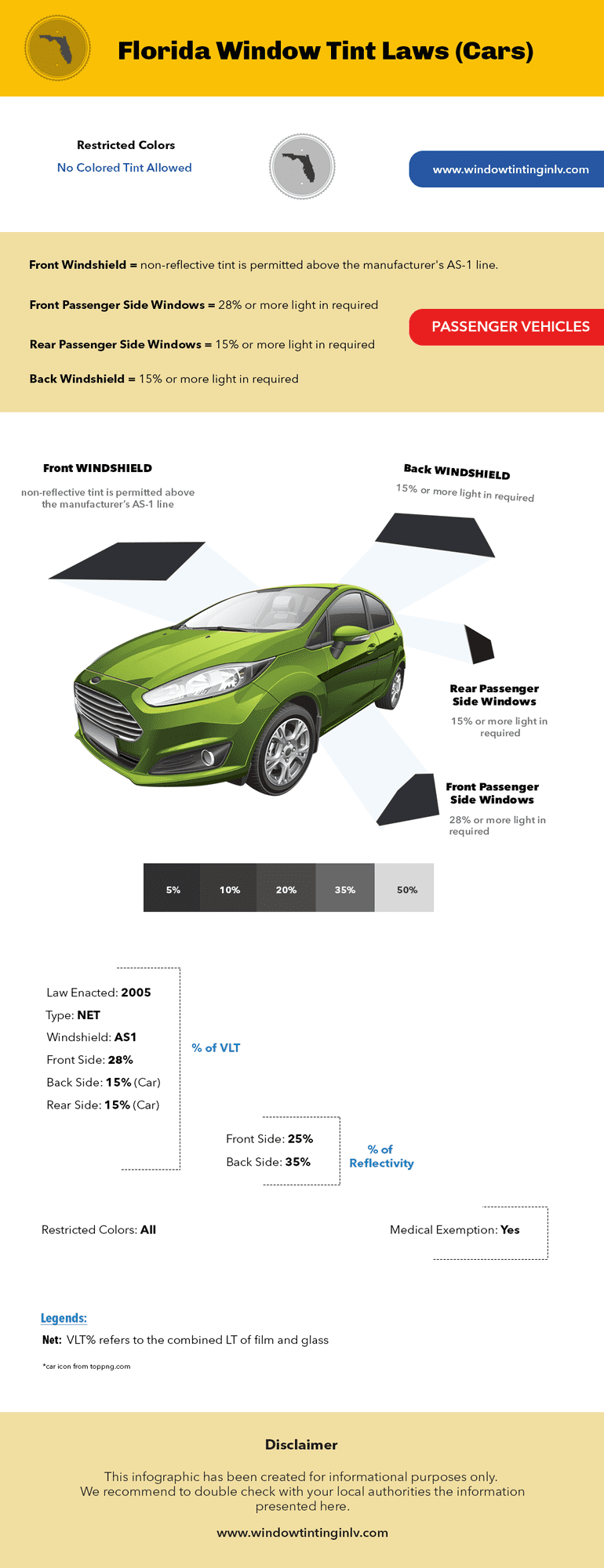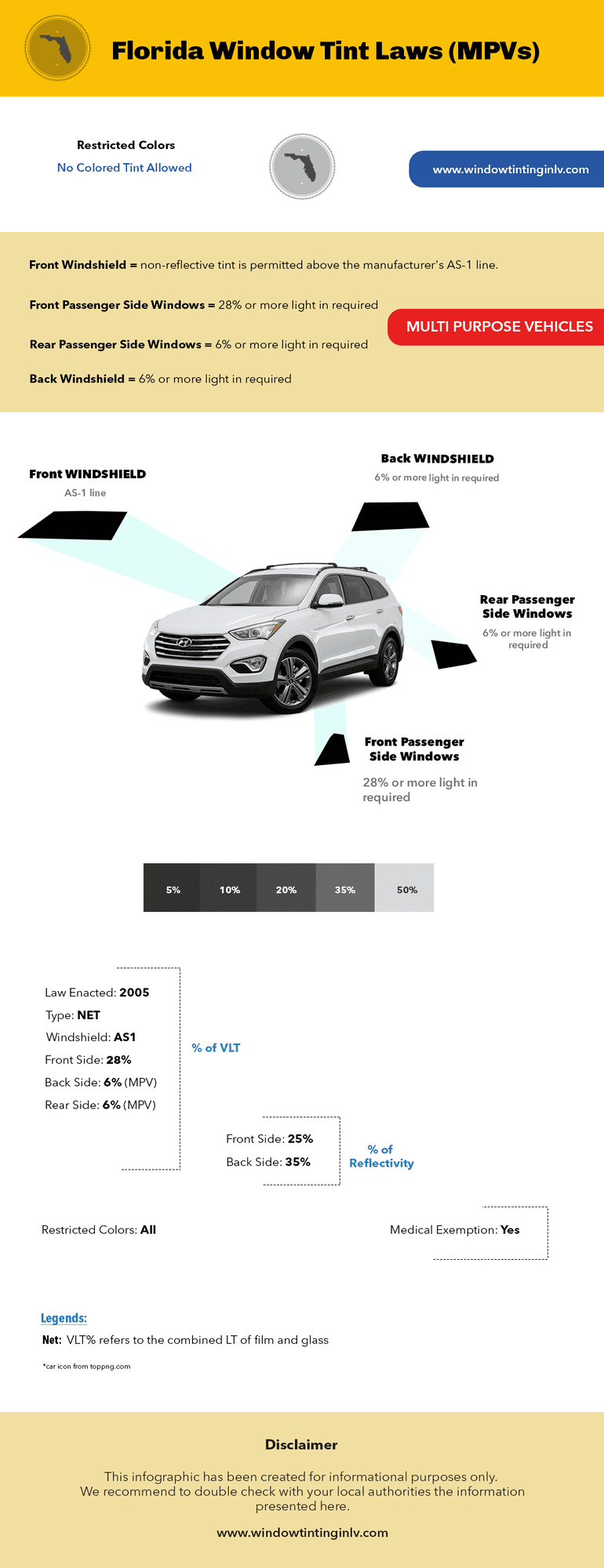
Disclaimer: As an Amazon Associate I earn from qualifying purchases.
Window tinting laws in Florida were enacted in 2005 and have been strictly enforced. While there are some exceptions, you must be aware of the regulations before planning to be a driver in Florida.
These rules state that windows in your vehicle must be tinted at most at a certain level and not more than the light transmission percentage of a certain wavelength.
In this article, we will walk you through Florida’s car window tinting laws and discuss the levels of tint permitted.
What Is VLT According to Florida Statutes?
VLT (Visible Light Transmission) measures the percentage of light that passes through your car’s window tint. The less VLT, the darker your window tint.
While most states mandate that all vehicles be within a certain VLT level range with no exceptions, Florida has different rules for different types of motor vehicles.
Florida Window Tint Laws for Sedans
Florida window tint laws for sedans are as follows:
- Rear window: 15% or more light is required
- Back seat side windows: 15% or more light is required
- Front seat side windows: 28% or light in required
- Front Windshield: non-reflective tint is permitted above the manufacturer’s AS-1 line.
Florida Window Tint Laws for Vans and SUVs
Florida window tint laws for Vans and SUVs are as follows:
- Rear window: 6% or more light is required
- Back seat side windows: 6% or more light is required
- Front seat side windows: 28% or more light is required
- Front Windshield: non-reflective tint is permitted above the manufacturer’s AS-1 line.
Window Tint Reflection in Florida
In Florida, window tint reflection is the same for both Passenger Cars and Multi-Purpose Vehicles.
For the front side windows, the reflection required by law is to be no more than 25%.
For the back side windows though no more than 35% is permitted.
Other Rules For Window Tint in Florida
If any back windows are tinted, then dual side mirrors are required.
As for the colors, the laws in Florida do not permit any colored window film.
If you wonder if certificates are required for film manufacturers, the short answer is no, there is no need to certify the film.
A sticker is required for legal tinting identification on the inside of the driver’s side door jamb.
Residents are allowed to apply for Medical exemptions in this state.


Is 5% Tint Legal in Florida?
Under Florida Chapter 493, some conditions will legally allow your vehicle to have up to 5 percent tint. However, you can only have a 5% tint on your vehicle if you’re using a vehicle that’s the agency licensed under this chapter and leased or owned by a private investigator.
If you’re a law enforcement representative used in undercover, canine operations or a medically exempt individual, you’ll also be permitted to use a 5% tint on your vehicle. You’ll need proof that you qualify for the condition set to have a 5% tinted vehicle.
Is 15% Tint Legal in Florida?
Under Florida’s window tinting laws, back-side windows, and rear windows must allow more than 15% light in the vehicle. For the front side windows though there is a 28% of light requested.
The law allows you to have an unlimited percentage of window tint if you’re a law enforcement agent, if your vehicle is medically exempt, or if your car is leased or owned by a private investigator.
Is 20% Tint Legal in Florida?
In Florida, the 20% tint darkness for your car’s front portion is considered illegal. However, for your passenger vehicle, you can have as low as 15% tint darkness on your back windows. As for the multipurpose vehicle, the limit on the back windows is 6% tint darkness.
What is The Legal Tint in Florida?
The legal tint in Florida is different for each kind of vehicle. While there is no official law stating the maximum window tint in Florida, the laws laid down will help you avoid having to pay hefty fines due to illegal window tinting.
The Florida window tint law states that if the combined factory tint of your car windows is above 70%, you’ll violate the law, which ensures that at least 28% of light can pass through your vehicle’s windows.
If you’re law enforcement or medical exemption, the law allows you to have up to 5% tint darkness on your vehicle. If combined with factory-tinted windows, you can have a 6% window tint for multipurpose vehicles.
Illegal Tint in Florida
The tint darkness level of your car window is determined by the Florida Motor Vehicle Code. You’ll violate the law if you have more than one window with a factory light transmission above 70%.
Using a window tint meter is a great way to determine the percentage of your tinted windows!
Using a window film with a light transmission lower than 6% is also illegal if you’re driving or riding in a multipurpose vehicle. You can also be subject to a fine if your windows do not comply with the law.
Residents are allowed up to 15% tint darkness on the rear and 28% on the front. Failure to comply with these rules can result in a hefty fine and a violation of your record.
Are Tinted Windows Legal in Florida?
According to the Florida tint laws, you can have as much window tint as the law allows. However, it’s important to note that if your vehicle is used for commercial purposes, you’ll need to have windows that are more than 70% light transmission.
If you’re using your car for personal use, you’re allowed up to 15% of tint darkness on each side of your car and 28% of light transmission on the front glass. If you’re a law enforcement person, the law allows up to 5% tint darkness for your vehicle.
Anything higher than that will be a violation of the law. You’ll also need to provide proof of your restrictions.
Is Ceramic Tint Legal in Florida?
Florida tint laws allow you to have ceramic tints on your car. However, ceramic tint is only permissible if combined with factory-tinted windows. You’ll also need to ensure that the total light transmission of your car windows is equal to or above 70%.
For multipurpose vehicles, the light transmission should not be less than 6% if you use ceramic film in your car windows.
Darkest Window Tint Legal in Florida
The Florida tint laws state that the tint darkness level of every window must be different. However, the rules for window tint are different for each vehicle. For example, you can have up to 15% of window tint allowed on your rear windows and up to 28% on your front.
If you’re a law enforcement person, the law allows up to 5% of light transmission for your vehicle. For multipurpose vehicles, the light transmission should be equal to or above 6%.
Conclusion of Window Tinting Laws in Florida
As a Florida resident, you shouldn’t be intimidated by the window tinting laws in Florida regarding tinting. By following the rules, you’ll avoid getting fined for having illegal window tinting on your car. Paying attention to the tint laws in Florida isn’t hard because they’re not super strict.
References
The 2022 Florida Statutes
State Window Tinting Rules & Laws
Check Out Other States Window Tint Laws:
Window Tint Law In California
Texas Window Tint Laws
Nevada Window tinting Laws
Window Tint Laws in Ohio
Window Tint Law in Virginia
North Carolina Window Tint Laws
Pennsylvania Tint Laws
Window Tint Law In Illinois
Window tint Law In Georgia
Michigan Window Tint Laws